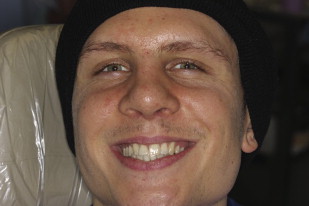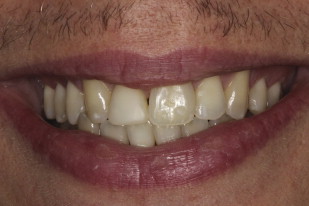Missing teeth in the esthetic zone, whether congenital or as a result of other factors, present difficult choices in clinical management. The missing teeth can be replaced by surgical or restorative intervention but are often treated orthodontically. These repositioned teeth often lead to an unaesthetic result because of differences in morphology, color, and particularly in gingival architecture. This article describes the use of multiple lasers for periodontal modification and feldspathic porcelain veneers to achieve a highly esthetic result.
Key points
- •
Missing teeth in the esthetic zone, whether congenital or as a result of other factors, present difficult choices in clinical management.
- •
The missing teeth can be replaced by surgical or restorative intervention but are often treated orthodontically.
- •
These repositioned teeth often lead to an unaesthetic result because of differences in morphology, color, and particularly in gingival architecture.
- •
The use of multiple lasers for periodontal modification and feldspathic porcelain veneers can help achieve a highly esthetic result.
Introduction
Dentists are frequently presented with the problem of missing teeth in the esthetic zone, whether caused by disease or trauma or they are congenitally missing. Most frequently this occurs with one or more lateral incisors but any of the anterior teeth can be affected. In adult patients, this is most often treated by placing an implant-supported restoration. Alternatively, a prosthetic replacement is chosen, such as a full-coverage supported fixed bridge or a pontic supported by one or more bonded retainers.
For adolescent patients, the decision may be made to move the teeth orthodontically to close the space. Although orthodontic treatment will be successful in closing the space left by the missing teeth, it is less successful in providing a truly esthetic result. Each tooth in the esthetic zone has a specific morphology and is very different in size and shape from its neighbors. This unique morphology is obvious in appearance and also has a different emergence profile from the tooth normally in that position, which results in gingival heights and contours that are unharmonious and unaesthetic.
When the restorative dentist is presented with the challenge of providing an esthetic makeover under these circumstances, it is important to deal not only with the teeth but also with the periodontal tissues. A complete periodontal evaluation is necessary to determine if the correction needed involves only the soft tissue or if osseous recontouring is necessary to achieve the desired result. Although osseous surgery can be affected by traditional means, such as scalpel and open flap surgery, advances in dental lasers have provided an alternative that has many advantages. The laser procedures are done without the problem of bleeding that hides the operative field and without the necessity for sutures. The use of lasers for periodontal modification also provides a predictable result that is essential in creating optimal esthetics.
Introduction
Dentists are frequently presented with the problem of missing teeth in the esthetic zone, whether caused by disease or trauma or they are congenitally missing. Most frequently this occurs with one or more lateral incisors but any of the anterior teeth can be affected. In adult patients, this is most often treated by placing an implant-supported restoration. Alternatively, a prosthetic replacement is chosen, such as a full-coverage supported fixed bridge or a pontic supported by one or more bonded retainers.
For adolescent patients, the decision may be made to move the teeth orthodontically to close the space. Although orthodontic treatment will be successful in closing the space left by the missing teeth, it is less successful in providing a truly esthetic result. Each tooth in the esthetic zone has a specific morphology and is very different in size and shape from its neighbors. This unique morphology is obvious in appearance and also has a different emergence profile from the tooth normally in that position, which results in gingival heights and contours that are unharmonious and unaesthetic.
When the restorative dentist is presented with the challenge of providing an esthetic makeover under these circumstances, it is important to deal not only with the teeth but also with the periodontal tissues. A complete periodontal evaluation is necessary to determine if the correction needed involves only the soft tissue or if osseous recontouring is necessary to achieve the desired result. Although osseous surgery can be affected by traditional means, such as scalpel and open flap surgery, advances in dental lasers have provided an alternative that has many advantages. The laser procedures are done without the problem of bleeding that hides the operative field and without the necessity for sutures. The use of lasers for periodontal modification also provides a predictable result that is essential in creating optimal esthetics.
Case presentation
The patient is a man in his early 20s endeavoring to be an actor. He presented to the honors esthetics clinic at the New York University (NYU) College of Dentistry complaining that he did not like the shape and color of his teeth. The examination revealed that a congenitally missing tooth No. 8 had been previously treated by orthodontically moving No. 7 to the No. 8 position, No. 6 to the No. 7 position, and No. 5 to the No. 6 position and the remaining teeth on the right side moved anteriorly to eliminate the resulting space. Although this treatment provided a fully dentate arch, it did not compensate for the discrepancy in shape, color, or gingival architecture between the newly positioned teeth and the contralateral arch ( Figs. 1 and 2 ). To evaluate the patient and determine the treatment necessary, an American Academy of Cosmetic Dentistry series of photographs, full series of radiographs, periodontal probing, and study models were taken; and an NYU College of Dentistry Esthetic Evaluation Form was completed.


Periodontal considerations
Evaluation of the tissues surrounding the teeth revealed a significant discrepancy in the gingival height and shape ( Fig. 3 A ). Full periodontal charting was within normal limits and indicated that the desired changes to the periodontal tissue of teeth No. 5 and No. 7 would invade the biological width (see Fig. 3 B, perio chart). If this was not dealt with by osseous surgery to restore appropriate architecture, the result could be chronic inflammatory disease in the area or uncontrolled recession depending on the tissue type. Measurement of the attached gingiva indicated sufficient tissue for periodontal alteration and the necessity to move the maxillary frenum attachment by frenectomy. This correction could be accomplished using scalpel reshaping and full-flap osseous contouring; but it was decided instead to use multiple laser wavelengths in a flapless technique, which would require no suturing and a shorter overall healing interval. The erbium laser has been shown to be effective in osseous recontouring with no collateral tissue damage and comparable healing with other methods.





